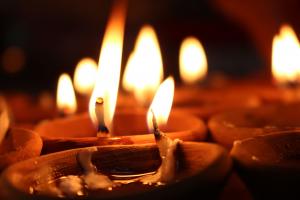HAF Interviews Three American Hindus About How They Celebrate Diwali
The "festival of lights" is celebrated differently depending on the region of India one hails from historically.
When I celebrate Diwali, I feel the same wonder I did as a child. In these humble ceremonies lies the deepest joy, tying me to my roots and carrying their light forward”
PHILADELPHIA , PA, UNITED STATES, October 9, 2025 /EINPresswire.com/ -- Every autumn, as nights grow longer and the air turns crisp, more than a billion people around the globe gather to celebrate Diwali — the “festival of lights.” In 2025, the main day of Diwali on October 20th.— Swati Arun
Many Hindus recognize Diwali as a day celebrating the return of Prince Rama of Ayodhya, his wife Sita, and brother Lakshman after 14 years of exile. Prince Rama is considered to be an incarnation of Lord Vishnu and an embodiment of dharma or righteousness; and Sita is an incarnation of Lakshmi, who is the Goddess of wealth and prosperity. The residents of Ayodhya were overjoyed at the return of their rightful King and lit lamps in his honor. Thus, the entire city looked like a row of lights. Other Hindus commemorate Diwali as the day Lord Krishna defeated the demon king Narakasura. For some regions of India, Diwali coincides with the Hindu New Year. Ever since, people light lamps at Diwali to remember that light triumphs over dark, knowledge prevails over ignorance, and good triumphs over evil.
These multiple ways of celebrating Diwali are illustrated crisply even on HAF’s team:
SWATI ARUN - SOCIAL MEDIA DIRECTOR
Growing up as a little girl in Bihar, Diwali was never just about fireworks or sweets — it was about the intimate ceremonies that made our home come alive with tradition. The one I cherish most is the making of the gharaunda, a small clay hut that my family and I would lovingly shape together. We decorated it with rangoli and diyas, then filled it with puffed rice and batasha or colorful sugar candy. This ceremony, especially carried out by young girls, seen as embodiments of Laxmi, held deep symbolism: the puffed rice represented abundance, the grains of harvest that sustained us, while the batasha, carried the sweetness we hoped for in life.
On Diwali night, after offering reverence to Laxmi and Ganesha, we performed dwar pooja at the entrance of our home, drawing tiny footprints to symbolize that Laxmi herself stepped inside our homes. And then came the moment I loved most, lighting one hundred mustard oil diyas. Their golden glow filled every corner, chasing away darkness and making even the quietest spaces feel sacred.
Even today, when I celebrate Diwali in this way, I feel the same wonder I did as a child — that in these humble ceremonies lies the deepest joy, tying me to my roots and carrying their light forward.
DEVALA REES - EDUCATION RESEARCH ASSISTANT
I like to celebrate Deepavali around close family when possible. In my family, our tradition is that on Deepavali night, Lakshmi Devi travels across the world and can be attracted into one’s home if it’s lit up nicely enough. For many other festivals we go to the mandir, but for Deepavali the main thing is we want Her to come and bless our home, so it’s not so much a temple festival.
Before Deepavali we clean our house from top to bottom as well as possible because Lakshmi is going to come as a guest. On the day of Deepavali we always have sacred chants to Lakshmi playing all day, and we do what chants we know ourselves, and sing to Her. Then for Deepavali night we hang many twinkling bright lights all around the house, outside and inside. We decorate our home more for Deepavali than for any other annual festival. We put the swastika outside near the doors, one near each entrance. And women in the family draw artistic rangoli patterns outside the door with rice, atta (whitish wheat flour), and some grass. We make sure every window has lights in it, to invite Lakshmi.
In the evening we give each other gifts of new clothes. We do a big puja to Ganesh and Lakshmi together, offering fruits, flowers, and lots of little diyas.
SANGEETHA SHANKAR - REGIONAL DIRECTOR, CALIFORNIA
Diwali celebrations at home are a mix of Tamil (South Indian) and Maharashtrian (Western Indian) traditions, due to our ancestral migration from the south to the west of India many decades ago.
The Tamil celebration is essentially just on the day of Narak Chaturdashi that commemorates Shri Krishna's killing of the vicious king Naraka, thus leading to the freedom of scores of enslaved women: having an oil bath first thing in the morning followed by wearing new clothes, taking blessings from the elders, eating the Diwali sweets and snacks, followed by bursting crackers/ fireworks in the evening in our backyard.
The Western Indian celebration falls on Laxmi Puja day (which occurs on the same day as Narak Chaturdashi during some years ) when we conduct an elaborate puja for Goddess Laxmi in the evening, while lighting the entire home with electric lights. We also draw elaborate rangolis with the whole family and place painted diyas around it.
Mat McDermott
Hindu American Foundation
mat@hinduamerican.org
Legal Disclaimer:
EIN Presswire provides this news content "as is" without warranty of any kind. We do not accept any responsibility or liability for the accuracy, content, images, videos, licenses, completeness, legality, or reliability of the information contained in this article. If you have any complaints or copyright issues related to this article, kindly contact the author above.

